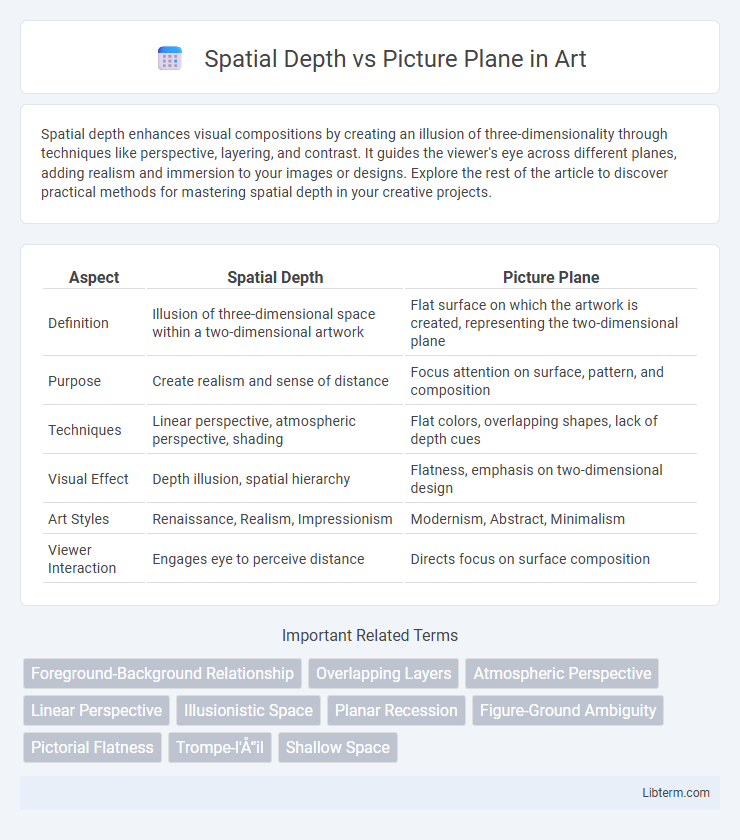Spatial depth enhances visual compositions by creating an illusion of three-dimensionality through techniques like perspective, layering, and contrast. It guides the viewer's eye across different planes, adding realism and immersion to your images or designs. Explore the rest of the article to discover practical methods for mastering spatial depth in your creative projects.
Table of Comparison
| Aspect | Spatial Depth | Picture Plane |
|---|---|---|
| Definition | Illusion of three-dimensional space within a two-dimensional artwork | Flat surface on which the artwork is created, representing the two-dimensional plane |
| Purpose | Create realism and sense of distance | Focus attention on surface, pattern, and composition |
| Techniques | Linear perspective, atmospheric perspective, shading | Flat colors, overlapping shapes, lack of depth cues |
| Visual Effect | Depth illusion, spatial hierarchy | Flatness, emphasis on two-dimensional design |
| Art Styles | Renaissance, Realism, Impressionism | Modernism, Abstract, Minimalism |
| Viewer Interaction | Engages eye to perceive distance | Directs focus on surface composition |
Introduction to Spatial Depth and Picture Plane
Spatial depth refers to the perceived distance between objects within a composition, creating a three-dimensional effect on a two-dimensional surface. The picture plane is the flat, physical surface of the artwork where the image is created, serving as the boundary between the viewer and the depicted space. Understanding the relationship between spatial depth and the picture plane is essential for artists to manipulate perspective and evoke a sense of realism or abstraction.
Defining the Picture Plane in Art
The picture plane in art refers to the two-dimensional surface on which an artist creates an image, acting as the window through which spatial depth is projected. Unlike spatial depth, which conveys the illusion of three-dimensionality and distance within the artwork, the picture plane remains flat and emphasizes the surface area occupied by shapes, colors, and forms. Understanding the picture plane is essential for artists to manipulate perspective, composition, and visual tension, balancing flatness with the perception of depth.
Understanding Spatial Depth: Concepts and Importance
Spatial depth refers to the perceived distance between objects within an image, creating a three-dimensional effect on a two-dimensional picture plane. Understanding spatial depth is crucial for artists and designers to convey realism, guide viewer focus, and enhance visual storytelling. Techniques such as overlapping, perspective, shading, and size variation effectively manipulate spatial depth to create a convincing sense of space.
Historical Context: Evolution of Depth in Visual Art
The evolution of spatial depth in visual art traces back to the Renaissance when artists first mastered linear perspective, transforming flat picture planes into immersive three-dimensional scenes. Early works often employed shallow depth, but innovations by pioneers like Brunelleschi and Leonardo da Vinci introduced mathematically precise vanishing points and horizon lines, redefining spatial representation. This historical shift enabled painters to create realistic illusions of depth, influencing centuries of artistic practice and the formal understanding of the picture plane.
Techniques for Creating Spatial Depth
Techniques for creating spatial depth in art include atmospheric perspective, where color and clarity fade with distance, mimicking the natural haze. Linear perspective uses converging lines to direct the viewer's eye into the depth of the composition, establishing a three-dimensional space on a two-dimensional picture plane. Overlapping forms and size variation further enhance the illusion of depth by establishing relative distances between objects within the scene.
Picture Plane Manipulation in Different Art Movements
Picture plane manipulation varies significantly across art movements, as seen in Cubism's fragmented geometry that flattens spatial depth to emphasize two-dimensionality. In Surrealism, altered picture planes create dreamlike distortions that challenge conventional perceptions of depth and reality. Abstract Expressionism often uses layered brushstrokes and textured surfaces on the picture plane to evoke emotional depth without traditional spatial representation.
Psychological Effects of Spatial Depth vs Picture Plane
Spatial depth in visual art creates a sense of three-dimensionality that evokes emotional responses such as immersion and tension by simulating real-world environments, enhancing viewer engagement. Picture plane, being flat and two-dimensional, often generates feelings of detachment or contemplation because it emphasizes surface patterns and composition over depth perception. The psychological effect of spatial depth triggers an instinctive spatial awareness, while the picture plane encourages intellectual reflection on form and structure.
Perspective and Its Role in Spatial Depth
Perspective creates the illusion of spatial depth by depicting objects smaller as they recede towards the picture plane, enhancing realism in two-dimensional art. Techniques such as linear perspective use vanishing points and converging lines to simulate three-dimensional space, guiding the viewer's eye through the composition. Mastery of perspective establishes a convincing spatial hierarchy, making flat images appear volumetric and immersive.
Comparing Abstract and Realistic Approaches
Spatial depth in realistic art uses techniques like linear perspective, shading, and overlapping to create an illusion of three-dimensional space on a two-dimensional picture plane. Abstract art often rejects traditional depth cues, favoring flatness and emphasizing color, shape, and texture to evoke spatial relationships without mimicking real-world depth. Comparing both approaches highlights how realism relies on visual accuracy, while abstraction prioritizes subjective interpretation and emotional impact through non-literal spatial arrangements.
Conclusion: Integrating Depth and Surface in Artistic Practice
Integrating spatial depth with the picture plane enhances the dynamic tension and visual interest in artistic compositions. Mastering the balance between three-dimensional illusion and two-dimensional surface allows artists to engage viewers more effectively by guiding perception and emphasizing narrative elements. This synthesis enriches aesthetic experience by combining structural depth cues with surface textures, color, and form.
Spatial Depth Infographic

 libterm.com
libterm.com